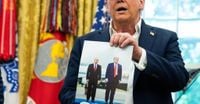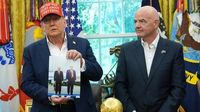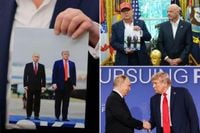On Friday, August 22, 2025, the White House found itself at the center of global attention—not for a policy announcement or a legislative breakthrough, but for an unexpected moment involving a photograph. President Donald Trump, during a press event in the Oval Office about the 2026 FIFA World Cup draw, held up a glossy picture of himself and Russian President Vladimir Putin, an image he said had been sent to him personally by Putin following their recent summit in Alaska.
"I was just sent a picture from somebody that wants to be there very badly," Trump told reporters, according to ABC News. "He's been very respectful of me and of our country, but not so respectful of others." The president, ever the showman, added, "I'm going to sign this for him. But I was sent one, and I thought you'd like to see it." He described the image as "a nice picture of him. Okay of me, but nice of him. So, that was very nice that it was sent to me."
The image, snapped just a week prior at their meeting in Anchorage, Alaska, marked a historic moment: it was the first time Putin had met with an American leader since the Russian invasion of Ukraine. The setting for this reveal was hardly coincidental. Trump was announcing that Washington would host the 2026 World Cup draw at the Kennedy Center, a major event for the city and the country. Yet, the conversation quickly shifted from soccer to geopolitics, as the photograph became a symbol of the current state of U.S.-Russia relations.
According to The Associated Press, Trump told those gathered that he planned to sign the photo for Putin, further underscoring the personal rapport he claims to have with the Russian leader. The president also hinted at the possibility that Putin might attend the World Cup, saying, "He may be coming and he may not, depending on what happens. We have a lot of things happening over the next couple of weeks." The implication was clear: the future of U.S.-Russia relations—and perhaps the broader security architecture of Europe—could hinge on events yet to unfold.
But beneath the surface of this lighthearted moment lay a much graver reality. The Alaska summit, held on August 15, 2025, was just the beginning of a flurry of diplomatic activity. Days after meeting with Putin, Trump welcomed Ukrainian President Volodymyr Zelenskyy and European leaders to the White House on August 18. The president announced he was working to arrange a bilateral meeting between Putin and Zelenskyy, aiming to jumpstart stalled peace talks between Russia and Ukraine.
Yet, the optimism was short-lived. On August 22, Russian Foreign Minister Sergey Lavrov told NBC News that no meeting between Putin and Zelenskyy was planned, stating, "Putin is ready to meet with Zelenskyy when the agenda is ready for a summit, and this agenda is not ready at all." Lavrov also made it clear that Moscow demanded a role in any security guarantees for Ukraine after the war, dismissing recent talks between NATO leaders and the U.S. as "futile." These comments underscored the deep divisions that remain between Russia and the West—and the significant obstacles to any meaningful peace process.
The diplomatic drama played out against the backdrop of escalating violence in Ukraine. Just a day before the Oval Office event, a Russian airstrike hit a U.S.-owned electronics factory in Ukraine. Trump, when asked for his reaction, didn't mince words. "I told that I'm not happy about it, and I'm not happy about anything having to do with that war," he said, as reported by Reuters. "No, I'm not happy about anything about that war. Nothing. Not happy at all. We'll see what happens. I say, over the next two weeks, we're going to find out which way it's going to go. And, I better be very happy."
Trump's comments left many wondering what concrete steps the United States might take in response to Russia's actions. The president made it clear that he was weighing his options. "It's gonna be a very important decision. And that's whether or not it's massive sanctions or massive tariffs or both, or do we do nothing and say, 'It's your fight,'" he said. According to CNN, Trump emphasized that he would make a decision within two weeks, stating, "I'm going to make a decision as to what we do. Whether or not it's massive sanctions or massive tariffs, or both, or do we do nothing and say, 'It's your fight'?"
Trump's approach—publicly displaying a personal gesture from Putin while threatening severe economic consequences—reflects the complex and sometimes contradictory nature of his foreign policy. On one hand, he has sought to cultivate a personal relationship with the Russian leader, even as tensions between their countries remain high. On the other, he has not hesitated to threaten punitive measures if diplomacy fails.
The president's remarks about the World Cup added another layer of intrigue. "That's a man named Vladimir Putin who I believe will be coming depending on what happens. He may be coming and he may not, depending on what happens," Trump said, referencing the possibility of Putin attending the 2026 FIFA World Cup in the U.S. The comment, though seemingly offhand, was loaded with diplomatic significance. Would Putin's attendance signal a thaw in relations, or would ongoing hostilities keep him away?
Meanwhile, the broader international community watched closely. The summit in Alaska was not just a bilateral affair; it carried implications for NATO, the European Union, and countries across the globe. Lavrov's insistence that Moscow be involved in post-war security guarantees for Ukraine was a reminder that any lasting peace would require difficult compromises and, likely, the involvement of multiple stakeholders.
For many observers, the juxtaposition of a lighthearted photo op and the grim realities of war underscored the challenges of modern diplomacy. Trump's willingness to oscillate between personal gestures and hardline threats left allies and adversaries alike guessing about America's next move.
As the world waits for the next chapter in this high-stakes drama, one thing is certain: the photograph of Trump and Putin, now famous in its own right, will be remembered as a symbol of a pivotal moment in U.S.-Russia relations—a moment when the future of peace in Europe hung in the balance, and the decisions made in the Oval Office had consequences far beyond its walls.


